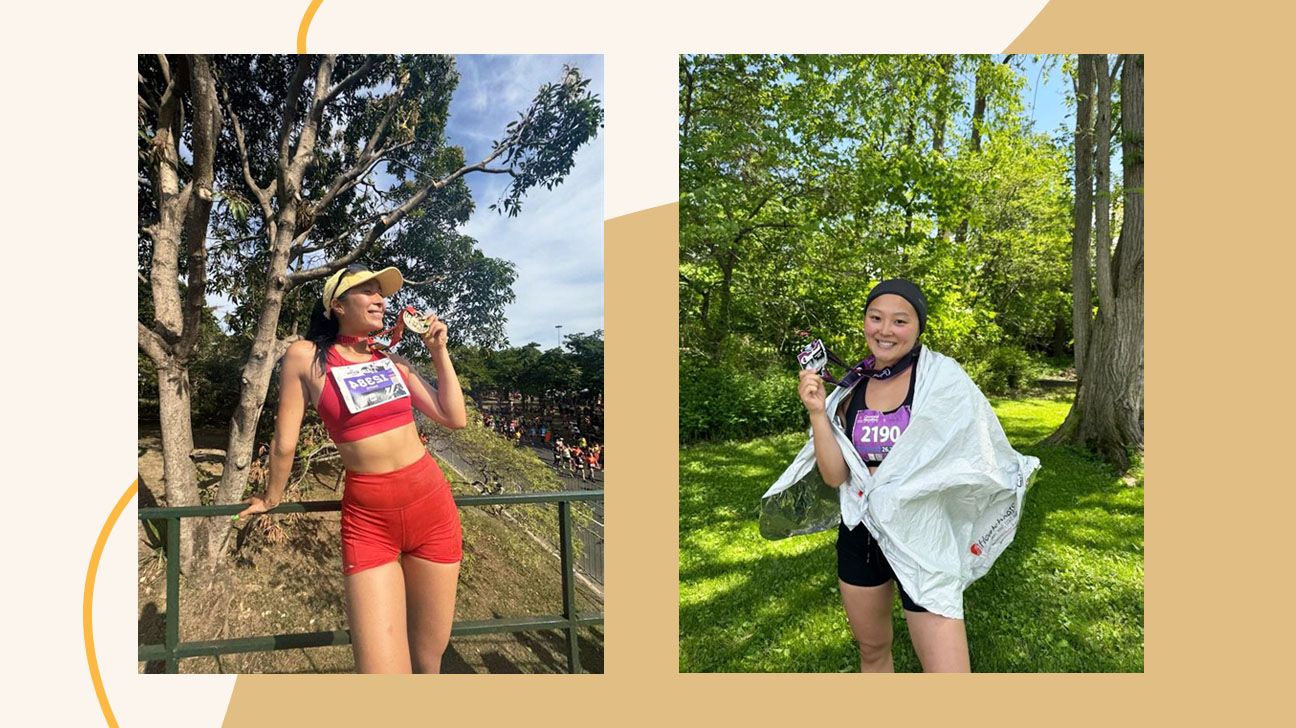
- Sister content creators Issa and Nadya Okamoto share their recent diagnoses with prediabetes.
- The sisters started running and training for marathons as a way to combat the condition.
- The Okamotos use a glucose monitor to help monitor how exercise, diet, and sleep impact their blood sugar levels.
Growing up, popular TikTok content creators Nadya and Issa Okamoto knew their mother had prediabetes. The condition causes elevated blood sugar levels that aren’t high enough to be considered type 2 diabetes.
The sisters remember watching their mom prick her finger to test her blood sugar levels.
“It looked so painful and I was honestly so scared,” Nadya told Healthline.
Now in their 20s, the sisters have both been diagnosed with prediabetes.
“The biggest shocker was the misconception I had that I wouldn’t need to worry about prediabetes until I was older, but I was diagnosed a little over a year ago,” Nadya said.
A few months after Nadya’s diagnosis, her younger sister Issa learned she has the same condition.
“We [told] our mom, ‘You were right, this is very real,’ and we’re taking it seriously now,” Issa told Healthline.
Prediabetes often runs in families
Prediabetes has a strong genetic component, which means it often runs in families, said Scott Isaacs, MD, president of the American Association of Clinical Endocrinology (AACE).
“Having a first-degree relative such as a parent or sibling with prediabetes or type 2 diabetes can increase your own risk by as much as 40%,” he told Healthline.
Additionally, research shows that Asian Americans are at a higher risk for developing prediabetes and diabetes compared to other racial and ethnic groups, even when they are at a lower body weight.
However, while genetic makeup may predispose people to prediabetes, lifestyle and environmental factors such as diet, physical activity, and body weight play an important role in whether that risk becomes reality, Isaacs noted.
For example, research shows that up to 70% of people with prediabetes may develop type 2 diabetes if no lifestyle changes are made, but this risk can be reduced by more than half with healthy habits.
“Understanding your family history is important, but focusing on positive lifestyle choices can significantly lower your risk regardless of your genetics,” said Isaacs.
Nadya and Issa witnessed this first-hand with their mother, who has remained in the prediabetic range and never developed type 2 diabetes.
“It was helpful growing up with her talking about it a lot and how her diet and exercise had impacted her symptoms, so we had a little bit of an idea of the pathway through prediabetes and how to manage it,” said Nadya.

Exercise like running can help with prediabetes
While Nadya and Issa have always lived healthy lifestyles, their prediabetes diagnoses pushed them to become more active.
Despite participating in daily Pilates classes, Nadya learned that she needed to ramp up her cardio.
“I specifically started running because my doctor said, ‘You are very prediabetic and you need to work out more,’” said Nadya.
Since her prediabetes diagnosis, Nadya has turned to running and has completed five marathons. She loves that marathons push her to think about her health holistically, from injury prevention and recovery to getting proper sleep and nourishing her body the best she can.
“I pay attention to what I eat because you have to fuel your body so much and you have to pay more attention to your glucose levels because a lot of times fueling for marathons is eating a lot of carbs and a lot of sugar, which is the first things they say to stay away from when you’re prediabetic,” she said.
Issa followed her older sister’s lead and ran her first marathon alongside her during the Cleveland Marathon in May.
“I joined Nadya on her training runs; that’s how I actually got into running, [but I saw] immediate results. Within in 15 minutes of getting home, I could see how my glucose was different and how it was impacted with running,” Issa said.
The Okamotos teamed up with Dexcom to use its latest technology Stelo. This technology sends glucose insights to their smartphones, helping them track how food, exercise, and stress affect their blood sugar levels.
“Wearing my Stelo glucose biosensor has been helpful because I’m able to simultaneously think about a holistic diet to maintain the energy that [I need] to be able to do marathons but also better understand how it’s going to affect my glucose levels,” said Nadya.
For Issa, monitoring her glucose levels helps her understand why she’s experiencing symptoms like headache, dizziness, and irritability.
While monitoring glucose can help people with prediabetes make informed choices about nutrition and exercise, Isaacs said it is not considered a standard treatment.
“Glucose levels naturally fluctuate throughout the day, and not every rise or fall is a cause for concern. For some, frequent monitoring can lead to unnecessary worry or stress about normal variations in blood sugar,” he said.
The information from a glucose monitor is most useful when interpreted with the guidance of a healthcare professional, who can help distinguish between typical changes and patterns that may need attention.
AACE recommends continuous glucose monitors (CGMs) for people with diabetes who take insulin or are at risk for low blood sugar.
“For those with prediabetes, short-term use of a CGM can be a helpful learning experience, but it may not be necessary to use these devices long term. The key is to use the information as a guide for making positive changes, rather than becoming overly focused on every number,” said Isaacs.
You don’t have to run a marathon to manage prediabetes
Marathons may not be everyone’s choice of exercise, and that’s OK.
A recent study found that engaging in 150 minutes of exercise per week can significantly reduce the progression from prediabetes to type 2 diabetes.
AACE recommends at least 150 minutes of moderate to vigorous exercise each week, such as brisk walking, cycling, swimming, or dancing.
“It’s helpful to also include resistance training, like weightlifting or yoga, two to three times per week to improve muscle strength, which decreases insulin resistance and improves insulin resistance,” said Isaacs. “It is also helpful to not be as sedentary and reduce long periods of sitting by standing or moving every half hour.”
In addition to exercise, Isaacs said the following are other ways to reverse prediabetes.
- Weight management: Losing 5–7% of your body weight can lower your risk of progressing to type 2 diabetes by more than half. “Set realistic goals and focus on long-term sustainable changes instead of fad diets,” Isaacs said.
- Nutrition: Avoid unhealthy foods like ultra-processed foods, saturated fat, high-sugar foods, and refined carbohydrates, such as sugary drinks, bread, and snack foods. Isaacs recommended a reduced-calorie diet with a balanced eating pattern, such as the Mediterranean diet, which includes vegetables, fruits, whole grains, lean proteins, and healthy fats. Increase fiber intake to 25–30 grams per day.
- Sleep: Aim for 7 to 9 hours of quality sleep each night. “Poor sleep or sleep deprivation can increase hunger and cravings for unhealthy foods and make weight and blood sugar harder to manage,” said Issacs.
- Stress management: Chronic stress can raise blood sugar levels. Incorporate stress-reducing activities such as meditation, deep breathing, yoga, or spending time in nature.
- Family and friends: Having a support system, like a friend or family member, can help you stay motivated and accountable.
- Don’t use tobacco: Avoid tobacco and minimize or avoid alcohol intake, as both can negatively affect blood sugar and overall health.
The Okamoto sisters are making strides to incorporate all of these lifestyle habits. While marathons are Nadya’s main outlet, she knows they are not the ultimate solution.
“Running marathons is not going to take away your prediabetes. You’d think I’m running 20 hours a week; this is going to be great, but it’s a huge part of my life and my glucose levels are still prediabetic five marathons in,” she said.
She and her sister hope sharing their experience with prediabetes will inspire others to pay attention to their health.
“I met a person who learned she had prediabetes after seeing a video I shared that explained the symptoms I was having before getting diagnosed, and she had similar symptoms, so she got tested,” said Issa. “Connecting with young women was very impactful and helpful to understand my own journey and create a community.”
Prediabetes Can’t Stop These Two Sisters From Training for Marathons
Source: Pinoy Lang Sakalam



0 (mga) komento:
Mag-post ng isang Komento